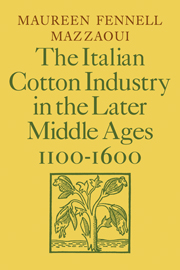Book contents
- Frontmatter
- Contents
- List of illustrations
- Preface
- List of abbreviations
- Map
- Introduction
- PART ONE THE ROLE OF COTTON IN THE MEDITERRANEAN ECONOMY
- PART TWO THE ORGANIZATION OF THE NORTH-ITALIAN INDUSTRY
- 3 The spread of cotton manufacture
- 4 Technological innovation
- 5 The structure of demand: products and markets
- 6 Guild and entrepreneurial structures
- PART THREE THE GROWTH OF COTTON MANUFACTURE NORTH OF THE ALPS
- APPENDICES
- Notes
- Select bibliography
- Index
6 - Guild and entrepreneurial structures
Published online by Cambridge University Press: 05 March 2012
- Frontmatter
- Contents
- List of illustrations
- Preface
- List of abbreviations
- Map
- Introduction
- PART ONE THE ROLE OF COTTON IN THE MEDITERRANEAN ECONOMY
- PART TWO THE ORGANIZATION OF THE NORTH-ITALIAN INDUSTRY
- 3 The spread of cotton manufacture
- 4 Technological innovation
- 5 The structure of demand: products and markets
- 6 Guild and entrepreneurial structures
- PART THREE THE GROWTH OF COTTON MANUFACTURE NORTH OF THE ALPS
- APPENDICES
- Notes
- Select bibliography
- Index
Summary
The economic corporations that evolved in the formative stages of the Italian communes gave rise to new occupational groupings that profoundly modified the traditional concept of artisan labor. The extant guild legislation constitutes our single most important body of information on medieval industrial organization. To this source must be added the directives of governmental organs and of powerful quasi-public entrepreneurial agencies which regulated and coordinated all aspects of production and marketing in the mainland cities of Lombardy and the Veneto. Changes or realignments in the composition and functions of these interrelated structures were not merely formal, but reflected significant secular trends in the relationship between capital and labor and the growing economic role of the state versus private enterprise.
The study of corporate organization is complicated by the fact that the surviving statutes are not a compact body of legislation but a series of dispositions emanating from guild, mercantile and communal councils that cover a broad span of time and are conditioned by a number of local political and economic factors. Many of the statutory codes are late in date and represent the end result of periodic revisions. Fortunately the dictates of legislative conservatism and the exigencies of public-record keeping tended to favor revisions in the form of additions or aggiunte appended to the original document. Thus it is frequently possible to extrapolate the primitive nucleus of the text through an examination of internal evidence.
- Type
- Chapter
- Information
- The Italian Cotton Industry in the Later Middle Ages, 1100–1600 , pp. 105 - 126Publisher: Cambridge University PressPrint publication year: 1981



